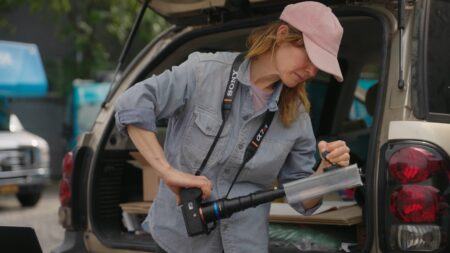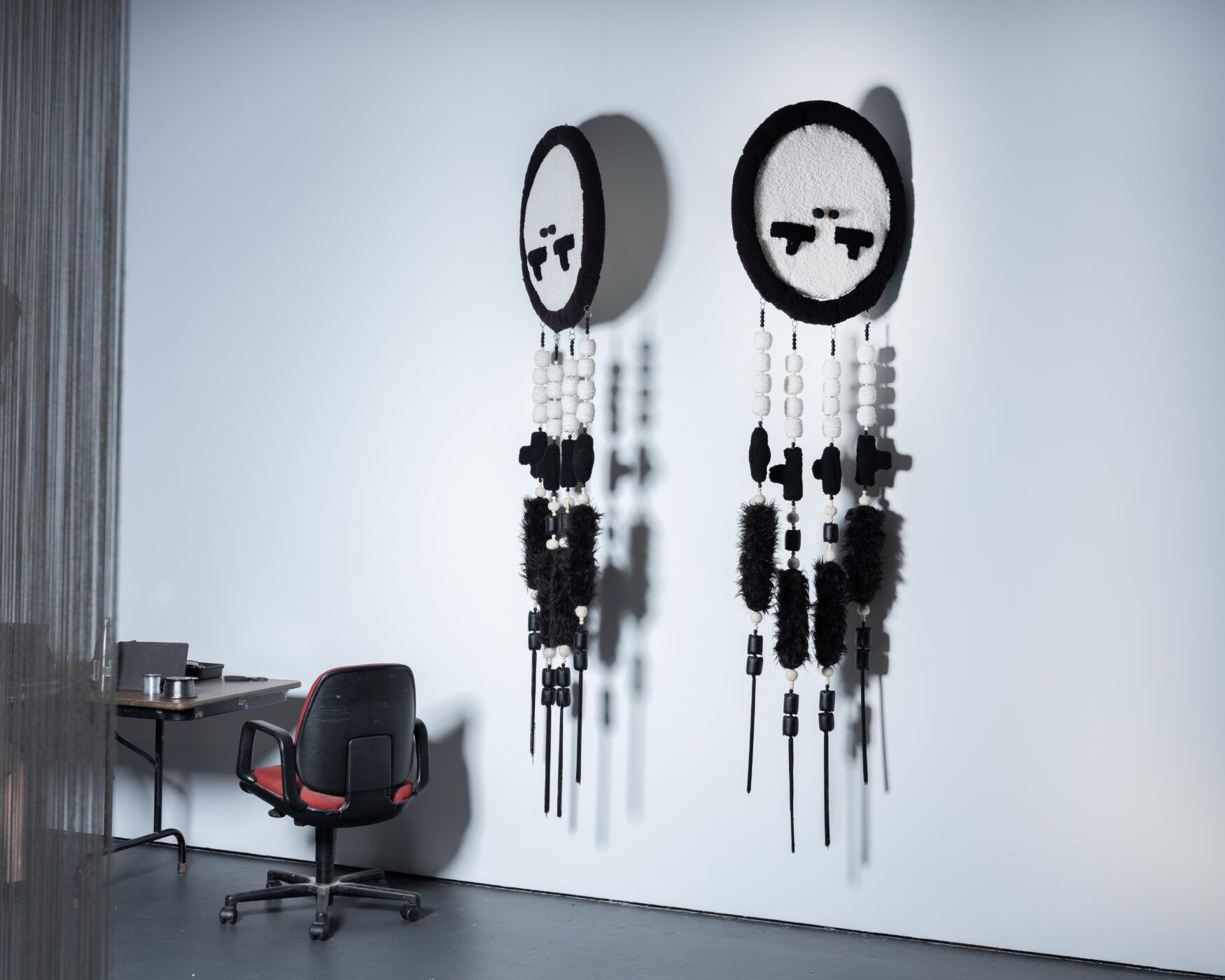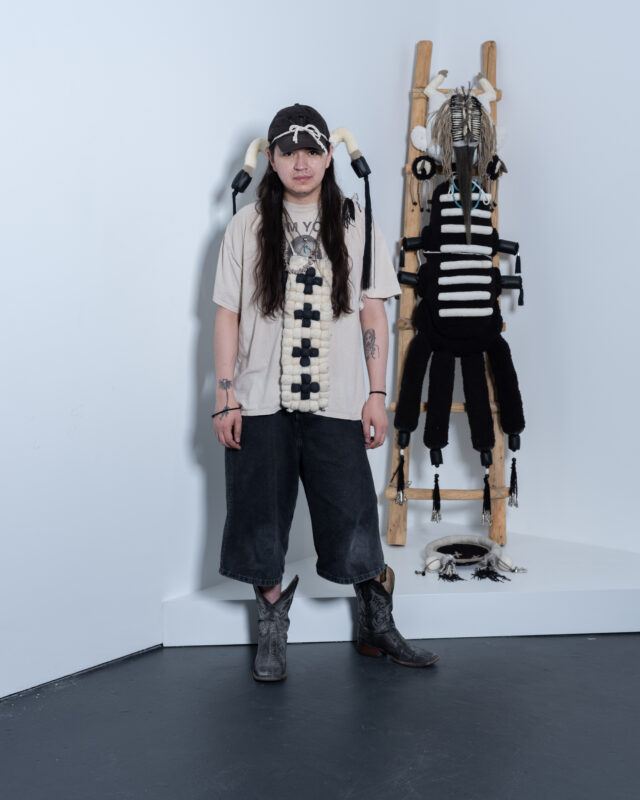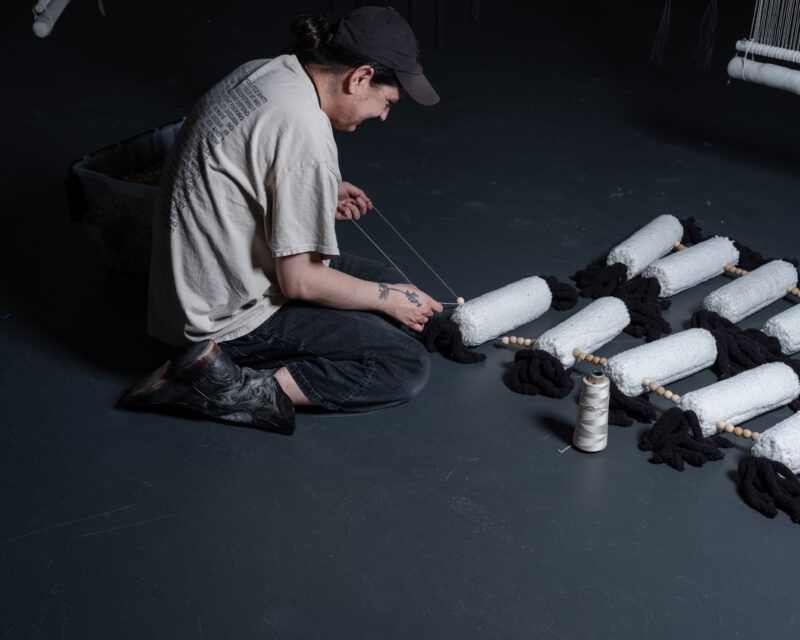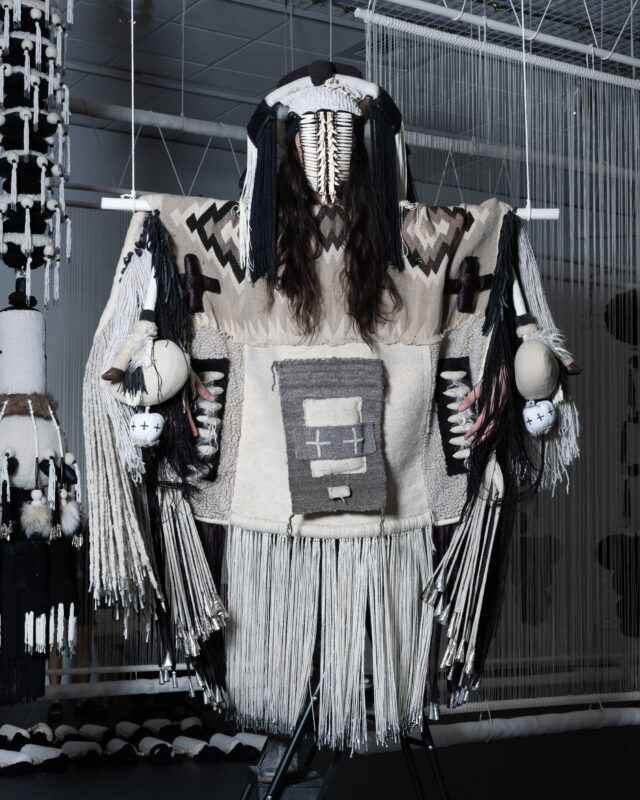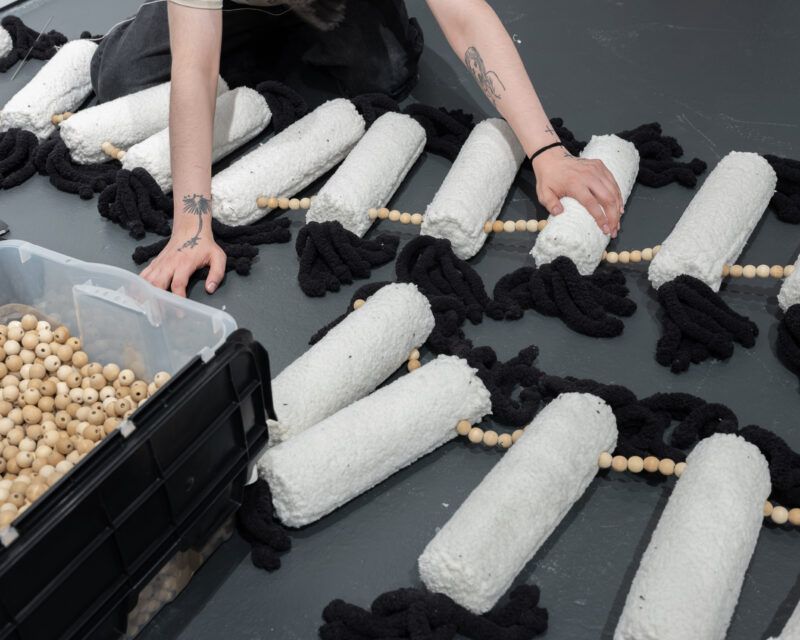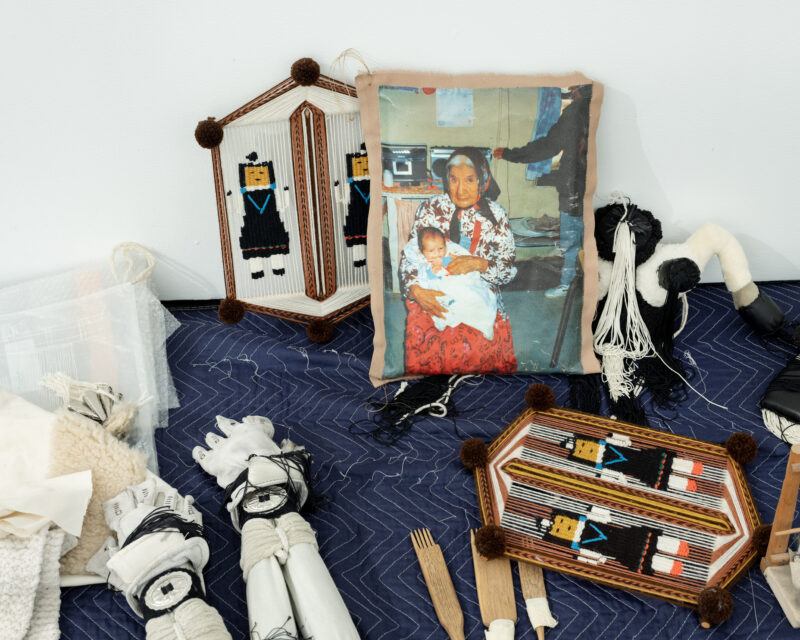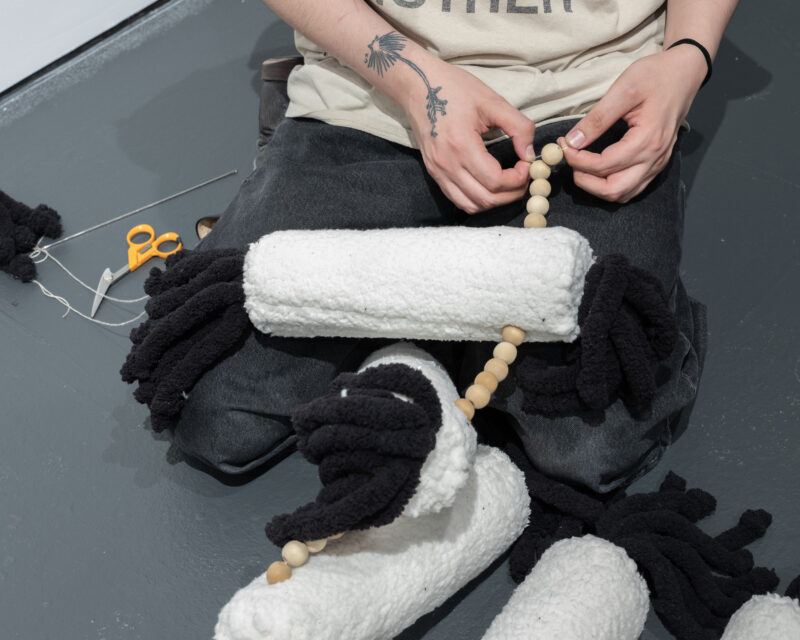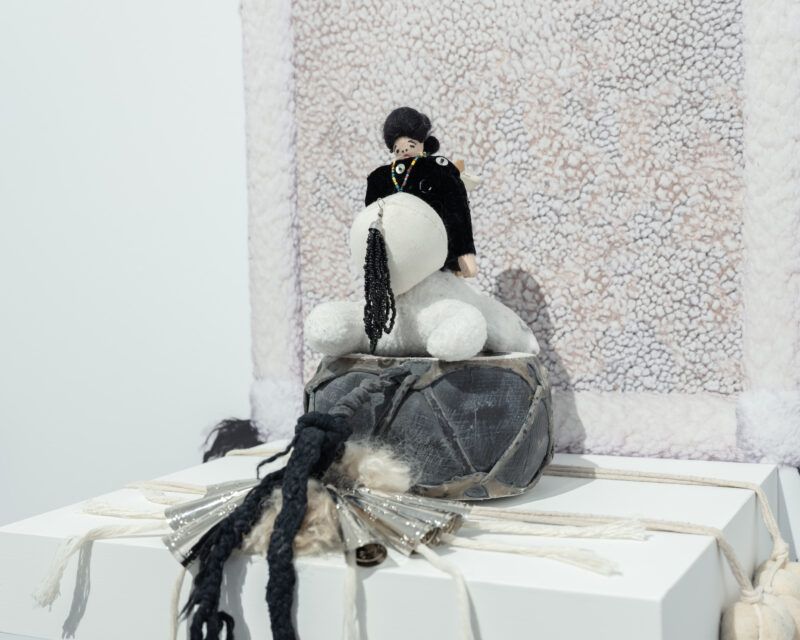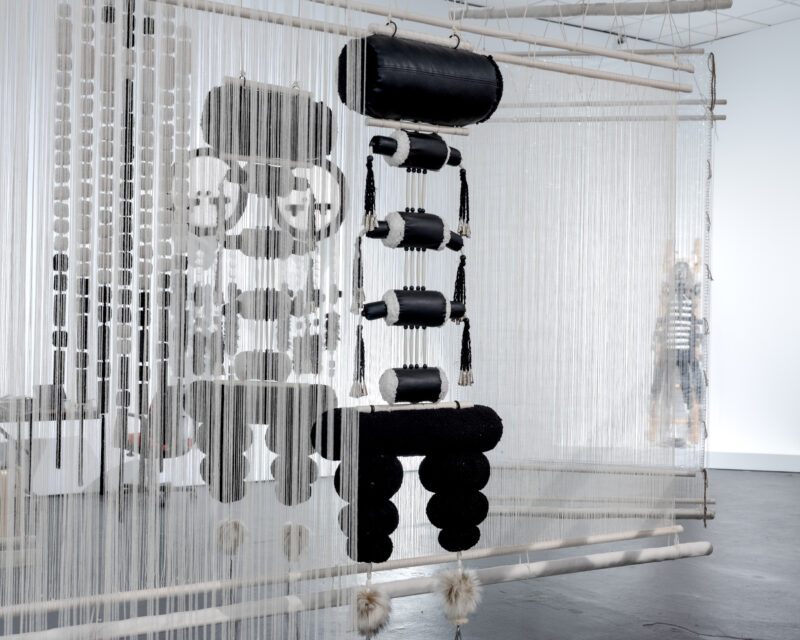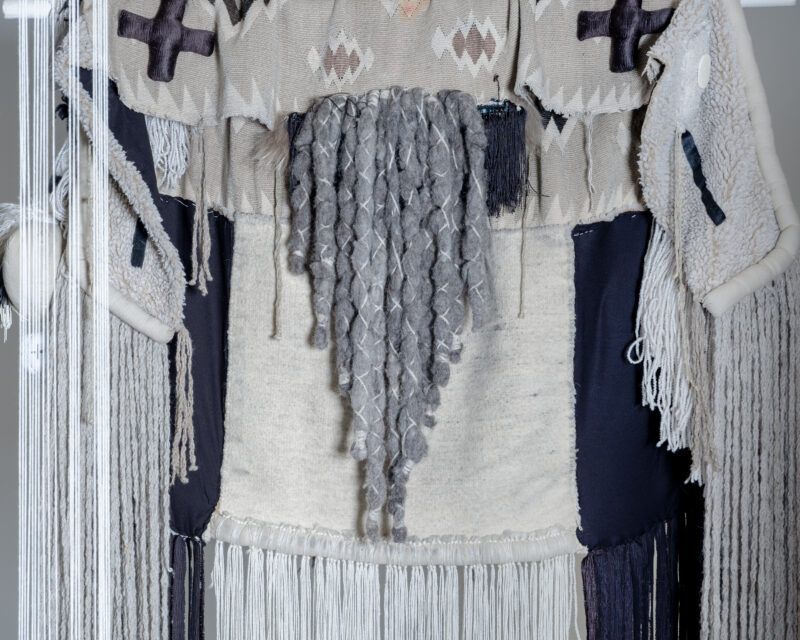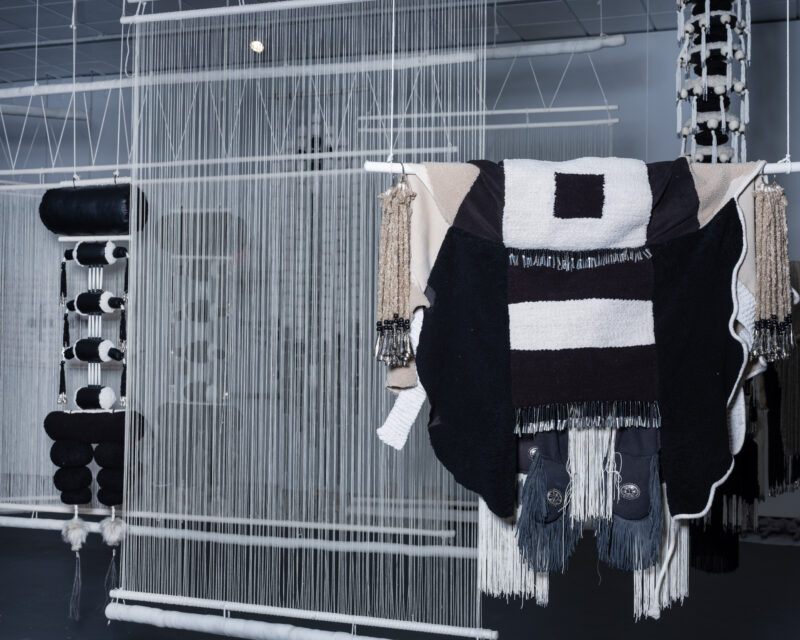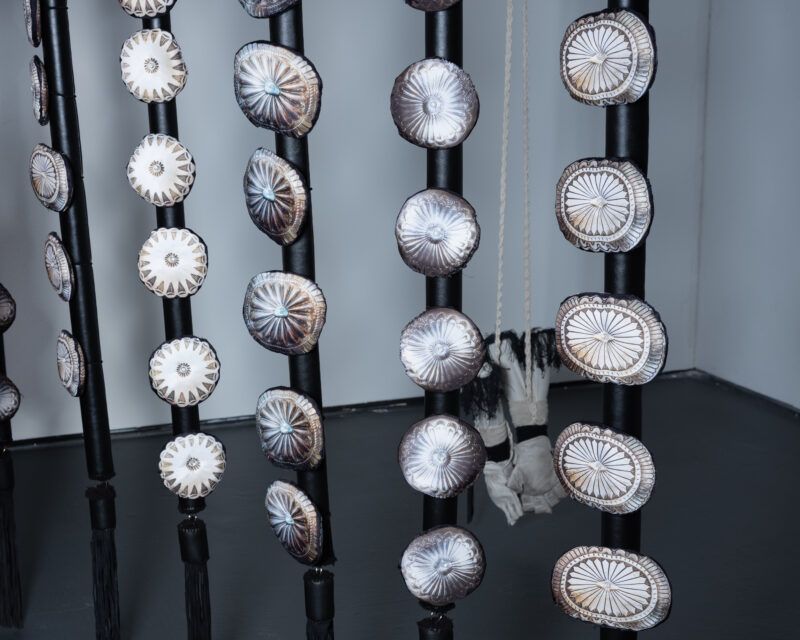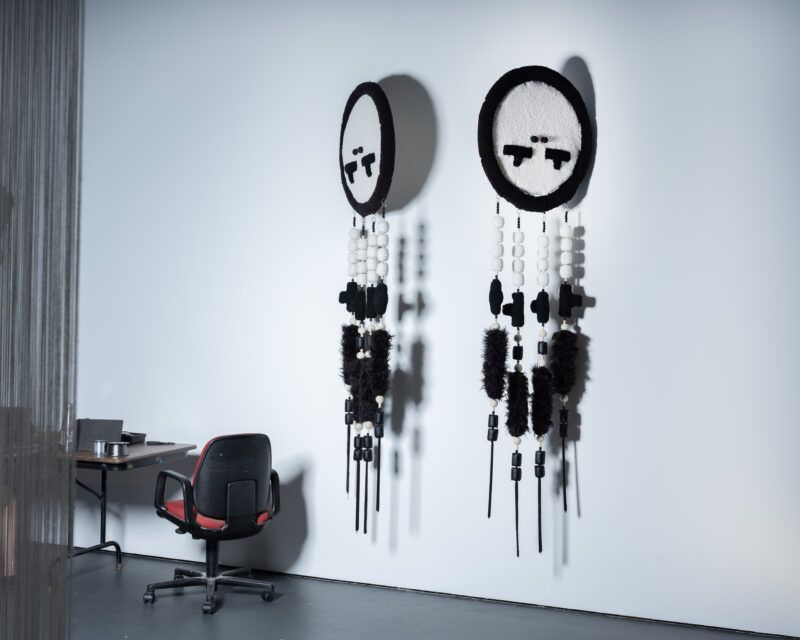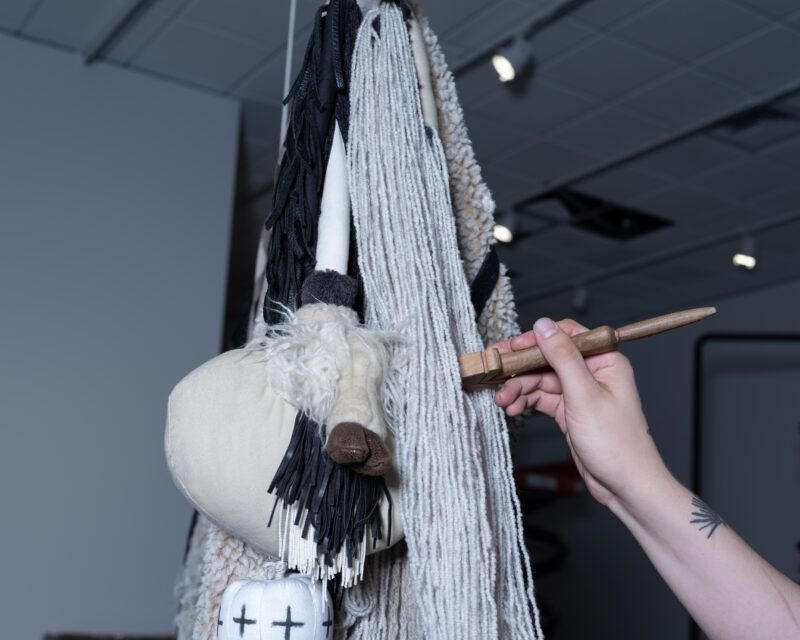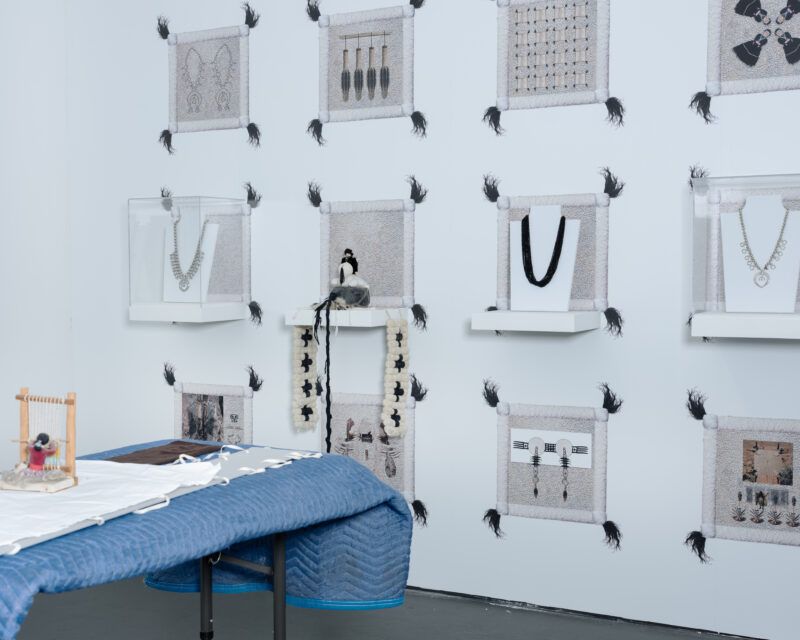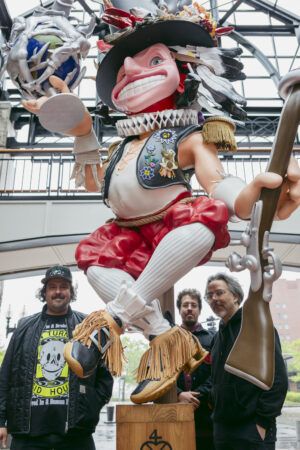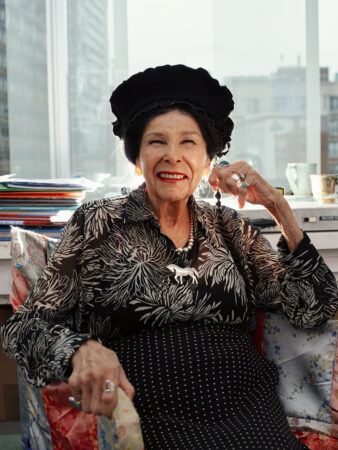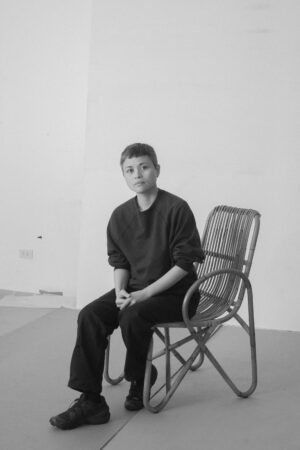Carina Martinez—Tell me about where you are right now and how this place informs the stories you tell through your multidisciplinary practice, which encompasses textile, sculpture, sound, and performance art.
Eric-Paul Riege–I’m currently at my home and studio in Gallup, New Mexico, which is in the northwest on the border of the Navajo reservation. My mom’s family is from around this area, and I was born here and still live here on the same block as my childhood home. My work is deeply informed by this place—not just Gallup, but this corner alone.
We have generations of Diné weavers in our family. My hands know what they’re doing before my brain does because of that connection to family and to the land. Being a weaver has allowed me to be patient with myself and others, and with the material.
A lot of my work is about celebrating not only my memories with my family in this place, but also an anthropomorphic interpretation of materials, showing traces of an object’s time on Earth. Not imposing a story on them, but bringing to light the life that already exists or persists within the materials that make their way to me. Each material either comes with or is impressed upon with marks that are indicative of their journey, whether that’s from the hands that manufactured the yarn or beads that I work into the artworks, to the run of an exhibition where the audience members are touching and molecularly altering the surfaces.
CM—Does this sensitivity to your materials’ past inform a certain way of thinking about the future of a work, or the storytelling it engenders over time?
EPR—My grandmother once told me that jewelry holds on to memory because of how we wear it: earrings are close to your ears, so they’re listening with you; a necklace is close to your heart, so it’s feeling with you; rings and bracelets are close to your hands, so they’re touching with you. These are temporary objects that you wear throughout the day, and whether you take them off and put them back on, they continue to carry the memory for you.
I think of my artworks as holders of memory for the time that I’m with them; therefore, they’re ever-evolving and modular by virtue of that. Even when my work is purchased or donated to museums, I often outline terms in the contract such that I’m allowed to borrow the work at some point in the future, reconfigure it, and return it to the collection in its new form. There are a couple of spaces, like the Forge Project, for instance, that understand that these objects are in constant flux and motion. When I make an artwork, I often see it as a self-actualizing thing that is limitless in its potential to change, to be adorned and unadorned in perpetuity.
The stories behind my jewelry sculpture series, which is called jaatłoh4Ye’iitsoh (2020-21), come from conversations with my grandmothers. Ye’iitsoh are monstrous gods that existed before us humans, and when they’re searching to protect or follow us, they look for our jewelry. I thought, if they know what our jewelry looks like, then they probably wore jewelry that looked like that, too. The series was born out of a childlike vision from hearing that story as a little kid and imagining this great giant wearing massive, dangly jewelry.
CM—Is there a reason why you make these monumental jewelry pieces from soft materials rather than hard metals or stones?
EPR—There’s something to be said about the soft things in life. During the day, we wear clothing and sit on cushioned seats, and at night, we lie on beds with pillows, blankets, and stuffed animals. All these soft, plushy things surround us and bring us comfort. I don’t think my work would be as effective if it were made out of metal, even if I were still making jewelry, because it wouldn’t be as inviting to touch. There’s also something kind of campy and queer about a weaving comb made from a stuffed animals: there’s a kitschy silliness in my work that maybe people don’t see if they don’t know me personally. I like laughing at the fact that I pretty much make pillows for a living.
The grease on your hands or the dirt under your fingernails when you touch soft objects is like a magnet for lint. I welcome that in my work because I feel like the life of this material, whether synthetic or organic, shouldn’t stop at me.
In terms of the works’ surface, particularly with Indigenous art and historical objects, the fading and scarring of materials often leads to speculation about their authenticity. Because of the soft materials, my pieces can look aged and weathered, which brings up questions about their value both to the art world and the industry of Indigenous objects in pawn-and-trade shops in the Southwest. It could have just been dropped outside, and now suddenly it’s regarded as more historical and valuable because it seems older. That’s something I like to play with, too, in terms of the anthropological flattening of “Native” art.
CM—You’ve spoken before about how the practices of U.S institutions (be they in the art market, in museums, or the pawn-and-trade shop economy of the Southwest) traditionally dictate what constitutes “Native American art,” often designating it as something frozen in time. I wonder if you could say more about this and how it has motivated your thinking for your upcoming show at Brown University.
EPR—A great example of this is the different weaving designs across the Navajo Nation. In different parts of the reservation, there are agencies, kind of like states, that make up the Navajo Nation and in certain locations, they have specific weaving styles. When you go to border towns, where we’re surrounded by the Navajo Reservation, all these weavers from different parts come into Gallup to sell their weavings. The person who owns the pawn-and-trade shop, and is typically non-Native, says, “This design is the best because it sells the most.” This alone can change the way makers create to meet demand and earn a living. The creation of the economy of Native art molded to what it is because of the popularity of certain designs. Those designs are then appropriated by retailers like Urban Outfitters, which were already appropriated from one Navajo community by another, all because of a person behind the counter who had the weaving under a glass because it was the most popular for the tourist economy. This idea of the “aficionado” still exists today in the form of some gallerists and art dealers, who see themselves as the tastemakers of Native American contemporary art.
I was uncomfortable the first time I visited a museum collection of Indigenous art. My second time was at the Haffenreffer Museum collection at Brown, and I felt more comfortable because my Navajo homie from Dinétah, Sháńdíín Brown, was there, whose ancestors and relatives created these objects. We were joking around, so it made it a little bit more lighthearted since those places tend to be so serious about the way objects are handled.
When we were there, I saw a weaving comb, broken and wrapped in a sample weaving. One of my Navajo teachers had told me that you’re never supposed to leave a weaving unfinished because, as you navigate the world, it will always be calling you back as a weaver, and your life is never going to be as fulfilled as it could be because of this unresolved thing that you forgot about.
And then I found that comb. It’s a tool meant to be activated by the body, it’s like an instrument waiting to be played, so it has that relationship with you. With it being wrapped in that way, we’re already going against what I was told.
That comb for me kind of became a tree root for a lot of the ideas in the exhibition at the Bell. The ideas, of course, are not answers, only questions that lead to further questions. They’re just explorations of my thoughts and my conflicting feelings. But the combs in the exhibition are a place of thinking about the archive. You’re also not supposed to display weaving combs as art, so we’re going to display that one and a couple of broken ones that my grandmother gave me. And then I’m making large soft sculpture combs.
CM—Talk about the role of performance and how this spatially ties into your sculptures. And maybe touch on how performance relates to the namesake of your upcoming exhibition, ojo|-|ólǫ́.
EPR—I was very performative in my identity as a teenager in terms of the way I dressed. Then I took a performance art class with Szu-Han Ho that completely changed my relationship with my own body and how it could be used for art. I started doing long performances that I called “weaving dances,” where I wore the work for several hours at a time. When I get to do exhibitions or projects, performance is always involved. I also don’t see my work as still or static when I’m away from it and not performing with it, it’s maybe just waiting for the next dance partner. That’s why I like audiences being able to move through installations, and I like them being condensed and almost a little claustrophobic, because as one moves through them, they will be bumped into and come to life and sing what they want to that visitor in that moment.
I thought about what has been passed down to me and how I can pass this down. So Hólǫ́ became a character in my work, whom I first called my son, born from the womb of my mind. I started to see him as a collaborator, alter ego, and persona, this figure that I create for and alongside.
He’s essentially a big doll made originally from a headdress and different parts that I’ve performed with in the past, his face is my old mask that I used to perform in for seven years. He’s grown to be my same age now, maybe someday he’ll be my elder.
Hólǫ́ in Navajo means “to exist” or “to be.” The first exhibition we made together was Hólǫ́—it xistz. I conceived of the installation from the point of view of a baby in a crib, with a little mobile above him that carries all these different stories and memories. The second one was a lullaby, which was about him playing with the work more, and them being like instruments, and audiences getting to play with them. And this is the third collaboration, which is ojo|-|ólǫ́. Ojo in Spanish means “eye,” so it means “I exist” or “eyes exist to see that which exists,” just a play on words.
CM—When making an artwork, what are your hopes for that creation that you’re bringing into the world for audiences to see? Thinking about the inherited knowledge and skills, is legacy through artmaking important to you?
EPR—It is, as an artist and a maker, I know this is what I was meant to do. This is a call that I’m going to keep answering and keep doing, and I’m so grateful that I get to be a student to the material forever, in the same way that I’m a lifelong student to the Navajo language. You only improve your craftsmanship over time.
In remaking some of the objects for this exhibition, I saw a change in even the way that I sew objects and approach their skeletal integrity. One hope that I have, which I have gotten to share with other artists when I lead student group workshops and after certain performances, is just like helping someone rethink their relationship to making and unmaking. I think about legacy in terms of conversations with people.
